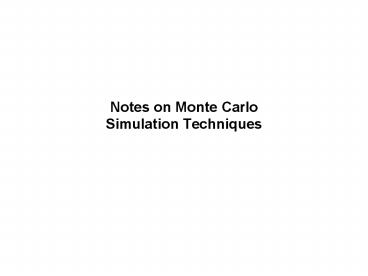Notes on Monte Carlo Simulation Techniques - PowerPoint PPT Presentation
1 / 11
Title:
Notes on Monte Carlo Simulation Techniques
Description:
Financial Modeling ... In traditional spreadsheet financial modeling, it is common to approach risk by ... major improvements to traditional financial modeling ... – PowerPoint PPT presentation
Number of Views:148
Avg rating:3.0/5.0
Title: Notes on Monte Carlo Simulation Techniques
1
Notes on Monte Carlo Simulation Techniques
2
Uncertainty, Risk and Traditional Financial
Modeling
- Financial decisions are made in an environment of
uncertainty about future outcomes - Uncertainty involves variables that are
constantly changing - E.g., the closing trading price of a stock on a
particular day or the sales of a firm in a
particular quarter - In such an environment, all decision-makers are
faced with the same level of uncertainty - In making financial decisions, we evaluate each
outcome from a risk-return standpoint
3
Uncertainty, Risk and Traditional Financial
Modeling
- Risk involves only the uncertain outcomes that
affect us in a direct way - Simply because we are faced with uncertainty does
not imply that we are also faced with risk - For example, a financial analyst in a
multinational firm is faced with the uncertainty
of the future value of the yen-dollar rate - However, only if this exchange rate affects this
firms bottom-line profits is the firm faced with
risk
4
Uncertainty, Risk and Traditional Financial
Modeling
- In traditional spreadsheet financial modeling, it
is common to approach risk by performing scenario
and sensitivity analysis - Scenario analysis implies altering key
assumptions (drivers) of the model to capture
certain assumed scenarios - For example, in the DCF valuation model, we could
alter the assumption about the growth rate of
sales during the forecast period to capture the
following three scenarios - High growth 15
- Average growth 10
- Low growth 5
5
Uncertainty, Risk and Traditional Financial
Modeling
- Sensitivity analysis involves making unit changes
of key assumptions (drivers) of the model and
examining the impact on outcome variables - This is captured through the inclusion of
sensitivity tables in the spreadsheet model - However, a major drawback of traditional
financial modeling is that it suffers from the
absence of any probabilities attached to the
values of key drivers in the model
6
What is Monte Carlo Simulation?
- Monte Carlo simulation techniques add two major
improvements to traditional financial modeling - The uncertainty of the values of the models
drivers is addressed by assigning predefined
probability distributions to those variables - The model is simulated thousands of times, given
different values of the drivers drawn from the
predefined probability distributions, to produce
associated results - The outcomes of the Monte Carlo simulation are
then tabulated into probability distributions
that allow us to evaluate the probabilities of
various outcomes in the model
7
Steps in Monte Carlo Simulation Process
- Step 1 Create the model (include the assumptions
(drivers) of the model and link the models
variables) - Step 2 Identify the probability distributions of
the models drivers - Step 3 Simulate the model (either use the
default number of trials and other preferences or
change these values before you run the
simulation) - Step 4 Interpret and evaluate the results of the
simulation
8
Identifying Probability Distributions of the
Models Drivers
- To identify the probability distribution(s) of
the models driver(s), it is proper to use
historical data for the particular variable - Having obtained historical data, the goal is to
match a probability distribution to the data - Exploring various distributions, we evaluate the
fit of the distribution based on some commonly
used goodness-of-fit tests, such as - Kolmogorov-Smirnov Test
- Anderson-Darling Test
- Chi-Square Test
9
Identifying Probability Distributions of the
Models Drivers
- Each goodness-of-fit test has its advantages and
disadvantages - However, a commonly used test is the Chi-Square
because it can be applied to both discrete and
continuous distributions while the other two
tests are restricted to continuous distributions - To identify the probability distribution for a
variable, select the probability with the lowest
value of the goodness-of-fit test
10
Interpreting Simulation Results
- The simulation outcomes are tabulated into
probability distributions - This distribution includes probabilities of all
possible outcomes from the simulation, meaning
that the area under the distribution is equal to
one - Two steps in interpreting these results are
interesting and useful to the analyst - Define a probability (certainty) level and obtain
the cutoffs of the corresponding confidence
interval - Specify a cutoff value of interest and obtain the
probability of observing outcomes above or below
that cutoff
11
Interpreting Simulation Results
- Another tool used to analyze simulation results
is the examination of sensitivity charts - Sensitivity charts identify the impact of the
models various drivers on the outcome(s) when
multiple interacting drivers are simulated
together - This tool enables the analyst to identify which
drivers are the most significant for the outcomes
produced by the simulation - Simulation software, such as Crystal Ball, allows
the analyst to easily produce these charts































